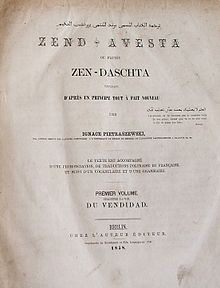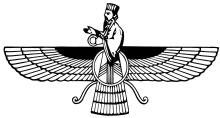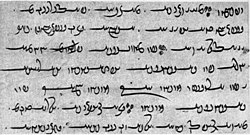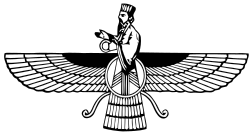Avesta
| Avesta | |
|---|---|
 French translation of the Avesta by Polish Orientalist Ignacy Pietraszewski,Berlin,1858. | |
| Information | |
| Religion | Zoroastrianism |
| Language | Avestan |
| Part ofa serieson |
| Zoroastrianism |
|---|
 |
|
|
TheAvesta(/əˈvɛstə/𐬎𐬞𐬀𐬯𐬙𐬀) is the primary collection ofreligious textsofZoroastrianismfrom at least the late Sassanid period (ca. 6th century CE).[1]It is composed in theAvestanlanguage,[2]with the oldest surviving fragment of a text in the Avestan language dating to 1323 CE.[2]
The Avesta texts fall into several different categories, arranged either bydialect,or by usage. The principal text in theliturgicalgroup is theYasna,which takes its name from the Yasna ceremony, Zoroastrianism's primary act of worship, and at which theYasnatext is recited. The most important portion of theYasnatexts are the fiveGathas,consisting of seventeen hymns attributed toZoroasterhimself. These hymns, together with five other short Old Avestan texts that are also part of theYasna,are in the Old (or 'Gathic') Avestan language. The remainder of theYasna's texts are in Younger Avestan, which is not only from a later stage of the language, but also from a different geographic region.
Extensions to the Yasna ceremony include the texts of theVendidadand theVisperad.[3]TheVisperadextensions consist mainly of additional invocations of the divinities (yazatas),[4]while theVendidadis a mixed collection of prose texts mostly dealing with purity laws.[4]Even today, theVendidadis the only liturgical text that is not recited entirely from memory.[4]Some of the materials of the extended Yasna are from theYashts,[4]which are hymns to the individualyazatas. Unlike theYasna,VisperadandVendidad,theYashts and the other lesser texts of the Avesta are no longer used liturgically in high rituals. Aside from theYashts, these other lesser texts include theNyayeshtexts, theGahtexts, theSiroza,and various other fragments. Together, these lesser texts are conventionally calledKhordeh Avestaor "Little Avesta" texts. When the firstKhordeh Avestaeditions were printed in the 19th century, these texts (together with some non-Avestan language prayers) became a book of common prayer for lay people.[3]
The termAvestais from the 9th/10th-century works of Zoroastrian tradition in which the word appears asMiddle Persianabestāg,[5][6]Book Pahlaviʾp(y)stʾkʼ.In that context,abestāgtexts are portrayed as received knowledge, and are distinguished from theexegeticalcommentaries (thezand) thereof. The literal meaning of the wordabestāgis uncertain; it is generally acknowledged to be a learned borrowing from Avestan, but none of the suggested etymologies have been universally accepted. The widely repeated derivation from*upa-stavakais from Christian Bartholomae (Altiranisches Wörterbuch,1904), who interpretedabestāgas a descendant of a hypotheticalreconstructedOld Iranian word for "praise-song" (Bartholomae:Lobgesang); but this word is not actually attested in any text.
Historiography[edit]
The surviving texts of the Avesta, as they exist today, derive from a single master copy produced by collation and recension in theSasanian Empire(224–651 CE). That master copy, now lost, is known as the 'Sassanian archetype'. The oldest surviving manuscript (K1)[n 1]of an Avestan language text is dated 1323 CE.[2]It is unlikely that any earlier copies exist, due to the fact that the Avestan language had no written form until the LateSasanian period(Aprox: 224 to 651AD).[1]
Summaries of the various Avesta texts found in the 9th/10th century texts of Zoroastrian tradition suggest that a significant portion of the literature in the Avestan language has been lost.[3]Only about one-quarter of the Avestan sentences or verses referred to by the 9th/10th century commentators can be found in the surviving texts. This suggests that three-quarters of Avestan material, including an indeterminable number of juridical, historical and legendary texts, have been lost since then. On the other hand, it appears that the most valuable portions of the canon, including all of the oldest texts, have survived. The likely reason for this is that the surviving materials represent those portions of the Avesta that were in regular liturgical use, and therefore known by heart by the priests and not dependent for their preservation on the survival of particular manuscripts. Interestingly, there is apparent similarity in language and mythology between theRigvedaand Avesta.[7]
A pre-Sasanian history of the Avesta, if it had one, lies in the realm of legend and myth. The oldest surviving versions of these tales are found in the ninth to 11th century CE texts of Zoroastrian tradition (i.e. in the so-called "Pahlavi books"). The legends run as follows: The twenty-onenasks ( "books" ) of the Avesta were created by Ahura Mazda and brought byZoroasterto his patronVishtaspa(Denkard4A, 3A).[8]Supposedly, Vishtaspa (Dk3A) or anotherKayanian,Daray(Dk4B), then had two copies made, one of which was stored in the treasury, and the other in the royal archives (Dk4B, 5).[9]Following Alexander's conquest, the Avesta was then supposedly destroyed or dispersed by the Greeks, after they had translated any scientific passages of which they could make use (AVN7–9,Dk3B, 8).[10]Several centuries later, one of theParthianemperors named Valaksh (one of theVologases) supposedly then had the fragments collected, not only of those that had previously been written down, but also of those that had only been orally transmitted (Dk4C).[10]
TheDenkardalso records another legend related to the transmission of the Avesta. In this story, credit for collation and recension is given to the early Sasanian-era priest Tansar (high priestunderArdashir I,r.224–242 CE, andShapur I,240/242–272 CE), who had the scattered works collected – of which he approved only a part as authoritative (Dk3C, 4D, 4E).[11]Tansar's work was then supposedly completed by Adurbad Mahraspandan (high priest ofShapur II,r.309–379 CE) who made a general revision of the canon and continued to ensure its orthodoxy (Dk4F,AVN1.12–1.16).[12]A final revision was supposedly undertaken in the 6th century CE underKhosrow I(Dk4G).[13]
In the early 20th century, the legend of the Parthian-era collation engendered a search for a 'Parthian archetype' of the Avesta. According to the theory of Friedrich Carl Andreas (1902), the archaic nature of the Avestan texts was assumed to be due to preservation via written transmission, and unusual or unexpected spellings in the surviving texts were assumed to be reflections of errors introduced by Sasanian-era transcription from theAramaic alphabet-derivedPahlavi scripts.[n 2]The search for the 'Arsacid archetype' was increasingly criticized in the 1940s and was eventually abandoned in the 1950s afterKarl Hoffmanndemonstrated that the inconsistencies noted by Andreas were actually due to unconscious alterations introduced by oral transmission.[14]Hoffmann identifies[15]these changes to be due,[16]in part, to modifications introduced through recitation;[n 3]in part to influences from other Iranian languages picked up on the route of transmission from somewhere in eastern Iran (i.e. Central Asia) via Arachosia and Sistan through to Persia;[n 4]and in part due to the influence of phonetic developments in the Avestan language itself.[n 5]
The legends of an Arsacid-era collation and recension are no longer taken seriously.[20]It is now certain that for most of their long history the Avesta's various texts were handed down orally,[20]and independently of one another, and that it was not until around the 5th or 6th century CE that they were committed to written form.[2]However, during their long history, only the Gathic texts seem to have been memorized (more or less) exactly.[4]The other less sacred works appear to have been handed down in a more fluid oral tradition, and were partly composed afresh with each generation of poet-priests, sometimes with the addition of new material.[4]The Younger Avestan texts are therefore composite works, with contributions from several different authors over the course of several hundred years.
The texts became available to European scholarship comparatively late, thus the study ofZoroastrianismin Western countries dates back to only the 18th century.[21]Abraham Hyacinthe Anquetil-Duperrontravelled toIndiain 1755, and discovered the texts among Indian Zoroastrian (Parsi) communities. He published a set of French translations in 1771, based on translations provided by a Parsi priest. Anquetil-Duperron's translations were at first dismissed as a forgery in poorSanskrit,but he was vindicated in the 1820s followingRasmus Rask's examination of the Avestan language (A Dissertation on the Authenticity of theZendLanguage,Bombay, 1821). Rask also established that Anquetil-Duperron's manuscripts were a fragment of a much larger literature of sacred texts. Anquetil-Duperron's manuscripts are at theBibliothèque nationale de France('P'-series manuscripts), while Rask's collection now lies in theRoyal Library, Denmark('K'-series). Other large Avestan language manuscript collections are those of theBritish Museum('L'-series), the K. R. Cama Oriental Library inMumbai,the Meherji Rana library inNavsari,and at various university and national libraries in Europe.
Structure and content[edit]
In its present form, the Avesta is a compilation from various sources, and its different parts date from different periods and vary widely in character. Only texts in the Avestan language are considered part of the Avesta.
According to theDenkard,the 21nasks (books) mirror the structure of the 21-word-longAhuna Vairyaprayer: each of the three lines of the prayer consists of seven words. Correspondingly, thenasks are divided into three groups, of seven volumes per group. Originally, each volume had a word of the prayer as its name, which so marked a volume's position relative to the other volumes. Only about a quarter of the text from thenasks has survived to the present day.
The contents of the Avesta are divided topically (even though the organization of thenasks is not), but these are not fixed or canonical. Some scholars prefer to place the categories in two groups, one liturgical, and the other general. The following categorization is as described by Jean Kellens (seebibliography,below).
TheYasna[edit]

TheYasna(fromyazišn"worship, oblations", cognate with Sanskrityajña), is the primary liturgical collection, named after the ceremony at which it is recited. It consists of 72 sections called theHa-itiorHa.The 72 threads of lamb's wool in theKushti,the sacred thread worn by Zoroastrians, represent these sections. The central portion of the Yasna is theGathas,the oldest and most sacred portion of the Avesta, believed to have been composed byZarathushtra (Zoroaster)himself. TheGathasare structurally interrupted by theYasna Haptanghaiti( "seven-chapterYasna"), which makes up chapters 35–42 of theYasnaand is almost as old as theGathas,consists of prayers and hymns in honor of Ahura Mazda, theYazatas,theFravashi,Fire, Water, and Earth. The youngerYasna,though handed down in prose, may once have been metrical, as theGathasstill are.
TheVisperad[edit]
TheVisperad(fromvîspe ratavo,"(prayer to) all patrons" ) is a collection of supplements to theYasna.TheVisparadis subdivided into 23 or 24kardo(sections) that are interleaved into the Yasna during a Visperad service (which is an extended Yasna service).
TheVisperadcollection has no unity of its own, and is never recited separately from the Yasna.
TheVendidad[edit]
TheVendidad(orVidēvdāt,a corruption of AvestanVī-Daēvō-Dāta,"Given Against the Demons" ) is an enumeration of various manifestations of evil spirits, and ways to confound them. TheVendidadincludes all of the 19thnask,which is the onlynaskthat has survived in its entirety. The text consists of 22Fargards, fragments arranged as discussions betweenAhura Mazdaand Zoroaster. The firstfargardis a dualisticcreation myth,followed by the description of a destructive winter (compareFimbulvetr) on the lines of theFlood myth.The secondfargardrecounts the legend ofYima.The remainingfargards deal primarily with hygiene (care of the dead in particular) [fargard3, 5, 6, 7, 8, 9, 10, 16, 17, 19] as well as disease and spells to fight it [7, 10, 11, 13, 20, 21, 22].Fargards 4 and 15 discuss the dignity of wealth and charity, of marriage and of physical effort, and the indignity of unacceptable social behaviour such as assault andbreach of contract,and specify the penances required to atone for violations thereof. TheVendidadis an ecclesiastical code, not a liturgical manual, and there is a degree ofmoral relativismapparent in the codes of conduct. TheVendidad's different parts vary widely in character and in age. Some parts may be comparatively recent in origin although the greater part is very old.
The Vendidad, unlike the Yasna and the Visparad, is a book of moral laws rather than the record of a liturgical ceremony. However, there is a ceremony called theVendidad,in which the Yasna is recited with all the chapters of both the Visparad and the Vendidad inserted at appropriate points. This ceremony is only performed at night.
TheYashts[edit]

TheYashts (fromyešti,"worship by praise" ) are a collection of 21 hymns, each dedicated to a particular divinity or divine concept. Three hymns of the Yasna liturgy that "worship by praise" are—in tradition—also nominally calledyashts, but are not counted among theYashtcollection since the three are a part of the primary liturgy. TheYashts vary greatly in style, quality and extent. In their present form, they are all in prose but analysis suggests that they may at one time have been in verse.
TheSiroza[edit]
TheSiroza( "thirty days" ) is an enumeration and invocation of the 30 divinities presiding over the days of the month. (cf.Zoroastrian calendar). TheSirozaexists in two forms, the shorter ( "littleSiroza") is a brief enumeration of the divinities with their epithets in the genitive. The longer (" greatSiroza") has complete sentences and sections, with theyazatas being addressed in the accusative.
The Siroza is never recited as a whole, but is a source for individual sentences devoted to particular divinities, to be inserted at appropriate points in the liturgy depending on the day and the month.
TheNyayeshes[edit]
The fiveNyayeshes, abbreviatedNy.,are prayers for regular recitation by both priests and laity.[3]They are addressed to theSunandMithra(recited together thrice a day), to theMoon(recited thrice a month), and tothe Watersand toFire.[3]TheNyayeshes are composite texts containing selections from the Gathas and the Yashts, as well as later material.[3]
TheGahs[edit]
The fivegāhs are invocations to the five divinities that watch over the five divisions (gāhs) of theday.[3]Gāhs are similar in structure and content to the fiveNyayeshes.
TheAfrinagans[edit]
TheAfrinagans are four "blessing" texts recited on a particular occasion: the first in honor of the dead, the second on the five epagomenal days that end the year, the third is recited at the six seasonal feasts, and the fourth at the beginning and end of summer.
Fragments[edit]
All material in theAvestathat is not already present in one of the other categories is placed in a "fragments" category, which – as the name suggests – includes incomplete texts. There are altogether more than 20 fragment collections, many of which have no name (and are then named after their owner/collator) or only a Middle Persian name. The more important of the fragment collections are theNirangistanfragments (18 of which constitute theEhrbadistan); thePursishniha"questions," also known as "FragmentsTahmuras";and theHadokht Nask"volume of the scriptures" with two fragments of eschatological significance.
See also[edit]
- Avestan,the language of the Avesta
- Avestan geography,the geographial horizon of the Avesta
- Avestan period,the time period of the Avesta
- Zoroastrian literature
References[edit]
Notes[edit]
- ^K1represents 248 leaves of a 340-leafVendidad Sademanuscript, i.e. a variant of aYasnatext into which sections of theVisperadandVendidadare interleaved. The colophon ofK1(K=Copenhagen) identifies its place and year of completion to Cambay, 692Y (= 1323–1324 CE). The date ofK1is occasionally mistakenly given as 1184. This mistake is due to a 19th-century confusion of the date ofK1with the date ofK1's source: in the postscript toK1,the copyist – a certain Mehrban Kai Khusrow of Navsari – gives the date of hissourceas 552Y (= 1184 CE). That text from 1184 has not survived.
- ^For a summary of Andreas' theory, seeSchlerath (1987),pp. 29–30.
- ^For example, prefix repetition as in e.g.paitī... paitiientīvs.paiti... aiienī(Y.49.11 vs. 50.9), orsandhiprocesses on word and syllable boundaries, e.g.adāišfor*at̰.āiš(48.1),ahiiāsāforahiiā yāsā,gat̰.tōifor*gatōi(43.1),ratūš š́iiaoθanāfor*ratū š́iiaoθanā(33.1).[17]
- ^e.g. irregular internalhw>xvas found in e.g.haraxvati- 'Arachosia' andsāxvan-'instruction', rather than regular internalhw>ŋvhas found in e.g.aojōŋvhant- 'strong'.[18]
- ^e.g. YAv.-ōinstead of expected OAv.-ə̄for Ir.-ahin almost all polysyllables.[19]
Citations[edit]
- ^abHintze, Almut."71. Book Chapter:" On editing the Avesta ". In: A. Cantera (ed.), The Transmission of the Avesta. Wiesbaden: Harrassowitz, 2012, 419–432 (Iranica 20)".Iranica 20.
- ^abcdBoyce 1984,p. 1.
- ^abcdefgBoyce 1984,p. 3.
- ^abcdefBoyce 1984,p. 2.
- ^Kellens 1987,p. 239.
- ^Cantera 2015.
- ^Bhattacharya, Tarapada (1970). "The Avesta, Rg Veda and Brhma Cult".Annals of the Bhandarkar Research Institute.51(1/4): 31–50.
- ^Humbach 1991,pp. 50–51.
- ^Humbach 1991,pp. 51–52.
- ^abHumbach 1991,pp. 52–53.
- ^Humbach 1991,pp. 53–54.
- ^Humbach 1991,p. 54.
- ^Humbach 1991,p. 55.
- ^Humbach 1991,p. 57.
- ^Hoffmann 1958,pp. 7ff.
- ^Humbach 1991,pp. 56–63.
- ^Humbach 1991,pp. 59–61.
- ^Humbach 1991,p. 58.
- ^Humbach 1991,p. 61.
- ^abHumbach 1991,p. 56.
- ^Boyce 1984,p. x.
Works cited[edit]
- Boyce, Mary (1984),Textual Sources for the Study of Zoroastrianism,Manchester UP.
- Cantera, Alberto (2015),"Avesta II: Middle Persian Translations",Encyclopedia Iranica,New York: Encyclopedia Iranica online.
- Hoffmann, Karl (1958), "Altiranisch",Handbuch der Orientalistik,I 4,1, Leiden: Brill.
- Humbach, Helmut (1991),The Gathas of Zarathushtra and the Other Old Avestan Texts,Part I, Heidelberg: Winter.
- Kellens, Jean (1983),"Avesta",Encyclopædia Iranica,vol. 3, New York: Routledge and Kegan Paul, pp. 35–44.
- Kellens, Jean (1987), "Characters of Ancient Mazdaism",History and Anthropology,vol. 3, Great Britain: Harwood Academic Publishers, pp. 239–262.
- Schlerath, Bernfried (1987), "Andreas, Friedrich Carl: The Andreas Theory",Encyclopædia Iranica,vol. 2, New York: Routledge and Kegan Paul, pp. 29–30.
External links[edit]
- avesta.org:translation byJames DarmesteterandL. H. Millsforms part of theSacred Books of the Eastseries, but is now regarded as obsolete.
- .Encyclopædia Britannica(11th ed.). 1911.
- The British Library: Discovering Sacred Texts – Zoroastrianism
